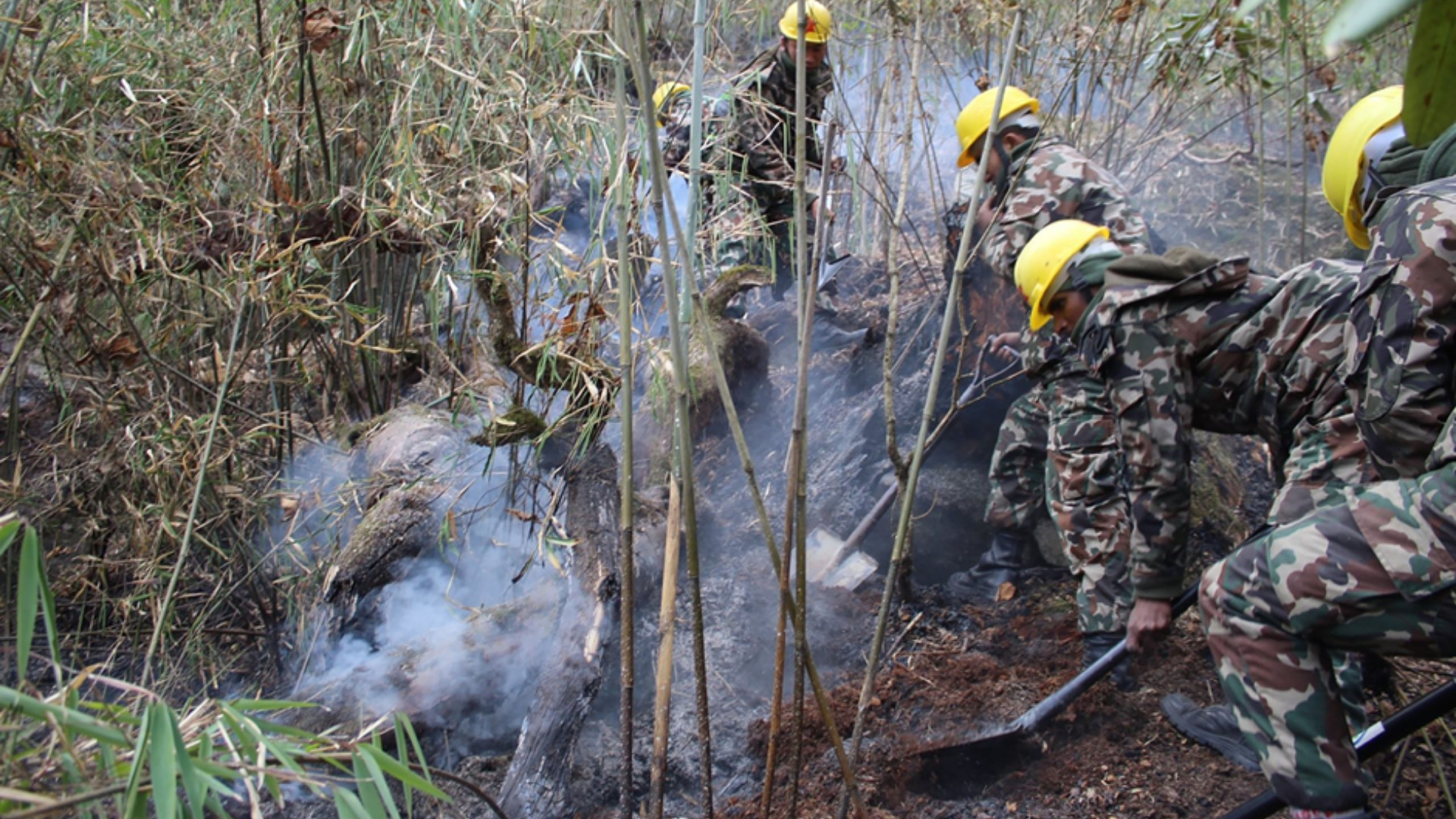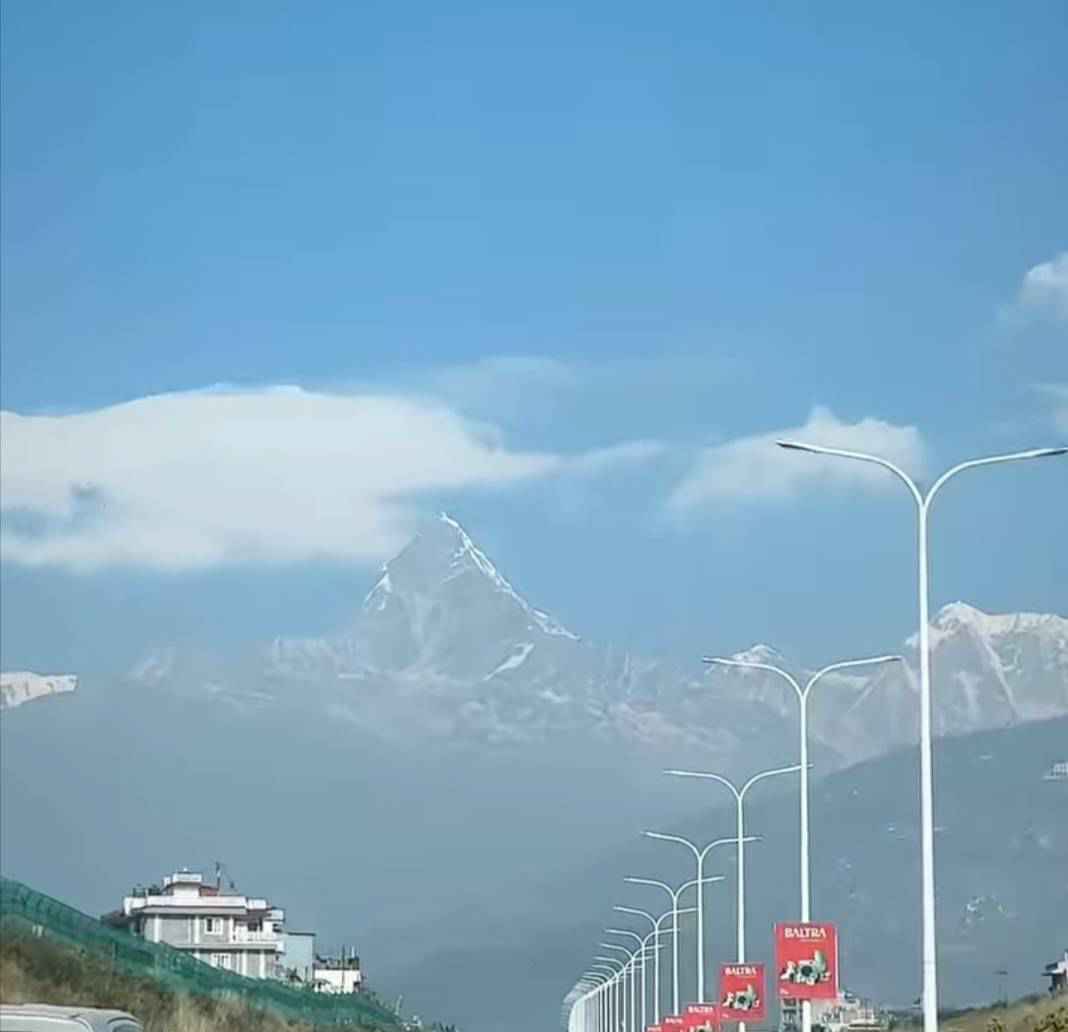Dry winter | Wildfire | Disaster Preparedness | Disaster Response | Disaster Management

On January 21, a wildfire broke out in Mahabharata forests of Kavrepalanchok district. It took authorities a week to secure control.
In three mountainous districts — Dolakha, Sindhupalchok and Manang, when they should be receiving snowfall, wildfires are ravaging the forests. With dry winter this year too, it’s certainly a wake up call to another intense and disastrous wildfire season.
The Kavre wildfire began in Thamlekh Danda of Khanikhola Rural Municipality, and soon spread to Ramite Danda and Jwanethumka of Bethanchok Rural Municipality, endangering settlements.
Security forces and the local community extinguished the fire on January 24 which was nearing settlements, along with mobilising a helicopter. According to Chini Kaji Shrestha, officer at Kavrepalanchok Division Forest Office, five community forests in both rural municipalities lost at least 100 hectares in total.
Following the fire, Narayanthan Temple in Bethanchok, a pilgrim site that attracts a significant number of visitors, was closed for the week. While the loss and damage is yet to be calculated, as informed by the forest office, estimates are the fire damaged high-value herbs and wildlife habitats.
Wildfires have also broken out in the mountainous Gaurishankar Conservation Area. According to the Forest Fire Detection and Monitoring System, the fire is blazing forests in Sindhupalchok at 4,000 metres above sea level and Dolakha 3,000 metres. Plume of smoke has affected lives in settlements downward.
Media reports suggest the fire has gone out of control as authorities fall short on navigating difficult terrains, simultaneously resulting in damage of Himalayan wild bamboo — habitats of Red Panda, among other wildlifes. They await for district disaster management committees and higher authorities to add on responses.
In another mountainous district Manang, efforts to contain the Timang wildfire that broke out above 4,000 metres in Chame Rural Municipality inside Annapurna Conservation Area has so far failed given difficult terrains.
Observers say wildfires in the months of January and February are unusual as it’s the time when mountain forests are covered with snow.
For instance, Mount Machhapuchchhre has received lesser than usual snowfall, which melts as soon as the Sun heats the mountain surface.
Social media was full of photographs of “naked Machhapuchchhre” and related discourses about impacts of global warming/climate change as the winter began. The engagements on posts have faded away, while the mountain still appears black (or dark) in lack of whitish snow.

The winter months (December 2024 to February 2025), like the past two years, remain dry this year too with precipitation recorded 5.5 mm, which is 9.2% of average 60.1 mm, suggesting extreme drought. It was recorded 1.9 mm (3.1%) last winter, fueling extreme wildfire events followed by thick smog in the air.
Similarly, the average temperature throughout the country has warmed up, according to the federal Department of Hydrology and Meteorology.
In December 2024, the Timang forest recorded 3-6 degrees celsius and the Gaurishankar forests 9-12 degree celsius as average maximum temperatures — with a positive departure of 1-2 degrees celsius, meaning the maximum temperature was hotter than normal.
Both the places reported average minimum temperature minus 3 to 0 degrees — with a positive departure of minus 2 to minus 0.2 degrees, meaning the minimum temperature was cooler than normal.
Temperature departure from normal, also known as temperature anomaly, refers to the difference between the actual observed temperature and the historical average or “normal” temperature for a specific location and time period.
Positive departure means hotter than usual and negative departure means cooler than usual.
While hotter maximum temperatures lead to faster moisture loss from vegetation, turning plants and dead leaves into highly flammable fuel, cooler minimum temperatures in lack of precipitation prevents the highly flammable fuel from decomposing. This phenomenon results in fuel accumulation in dry winters, allowing little sparking to light intense wildfires.
On January 31, the federal Ministry of Forests and Environment organised a stakeholders interaction on wildfire control.
Representatives of the concerned bodies participating in the program suggested that a special program should be conducted for wildfire prevention and control from mid-February (Falgun) to mid-June (Jestha), including door-to-door, social media, school and community campaigns for public awareness.
For protected areas, a Nepali Army team should be mobilised with proper firefighting gears and resources like fire engines and helicopters covered by insurance, treatment facilities, and food supplies.
Joint Secretary Dipak Gyawali, chief of the ministry’s Forest and Watershed Division, highlighted difficult terrain, lack of gears, expensive and resource-intensive fire control and limited traditionally trained human resources as challenges.
Wildfire expert Sundar Sharma suggested consolidating scattered plans, budgets, and human resources and enhancing their capacity; creating fire lines and raising public awareness about preparedness and prevention measures at the community level.
But it’s all redundant.
When Neglected flames: Nepal’s wildfire crisis was published in November 2024, wildfires had subsided — with 5,125 incidents reported between January 1 and June 21, 2024.
Peaked in April-May, the flames claimed 17 lives, and unaccounted hectares of forest land, vegetation, biodiversity and ecosystem, and forest-related products in over 50 districts.
Between June 22 to December 31, 2024 — little over six months — the country reported only 80 incidents of wildfires. Thirty-six days later, from January 1 to February 5, 2025, the number of incidents are 190 — which is 85 more than last year in the same period.
The National Disaster Risk Reduction and Management Authority (NDRRMA) has a budget of NRs 12.5 million to spend on wildfire control this fiscal year.
Add another NRs 2.5 million with the federal forest department. A source there had confirmed in our earlier piece that budget requests for various works including study and research and community discussions on wildfire were rejected.
For control and prevention, the state needs to spend a good amount on acquiring resources and, as the weather pattern becomes unpredictable, launch studies on wildfires to inform risk mitigation and adaptation efforts.
Read More Stories
Kathmandu’s decay: From glorious past to ominous future
Kathmandu: The legend and the legacy Legend about Kathmandus evolution holds that the...
Kathmandu - A crumbling valley!
Valleys and cities should be young, vibrant, inspiring and full of hopes with...
The majestic Upper Mustang and its water troubles
The wind stirs heavily across the barren landscape as our bus pushes along...